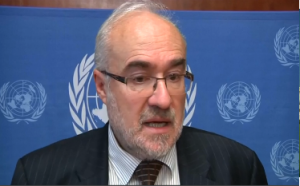
(Reuters) — Atmospheric volumes of greenhouse hit a record in 2013 as carbon dioxide concentrations grew at the fastest rate since reliable global records began, the World Meteorological Organization said on Tuesday (September 9).
The volume of carbon dioxide, or CO2, the primary greenhouse gas emitted by human activities, was 396.0 parts per million (ppm) in 2013, 2.9 ppm higher than in 2012, the largest year-to-year increase since 1984, when reliable global records began.
The second most important greenhouse gas, methane, continued to grow at a similar rate to the last five years, reaching a global average of 1824 parts per billion (ppb). The other main contributor, nitrous oxide, reached 325.9 ppb, growing at a rate comparable to the average over the past decade.
“For CO2 but also for Methane, for other greenhouse gases, the concentration keeps on increasing. And that, year after year, we break new records. But this year an important addition news is that the rate of increase of CO2 concentration is even faster than previous years. Actually it was the fastest rate over more than 30 years. So in other words we are not in a period where the emissions start to plateau and to diminish, rather they tend to increase even faster,” said WMO Secretary-General Michel Jarraud after WMO released its annual Greenhouse Gas Bulletin.
The world has the knowledge and tools to keep global warming within 2 degrees Celsius (3.6 Fahrenheit), a U.N. goal set in 2010, Jarraud said but only if urgent action is taken.
“The more we wait, the more challenging it will be, the more expensive it will be and at some point the goal to decrease will no longer be achievable if we don’t take action now. It’s still possible but it requires urgent action,” he said.








